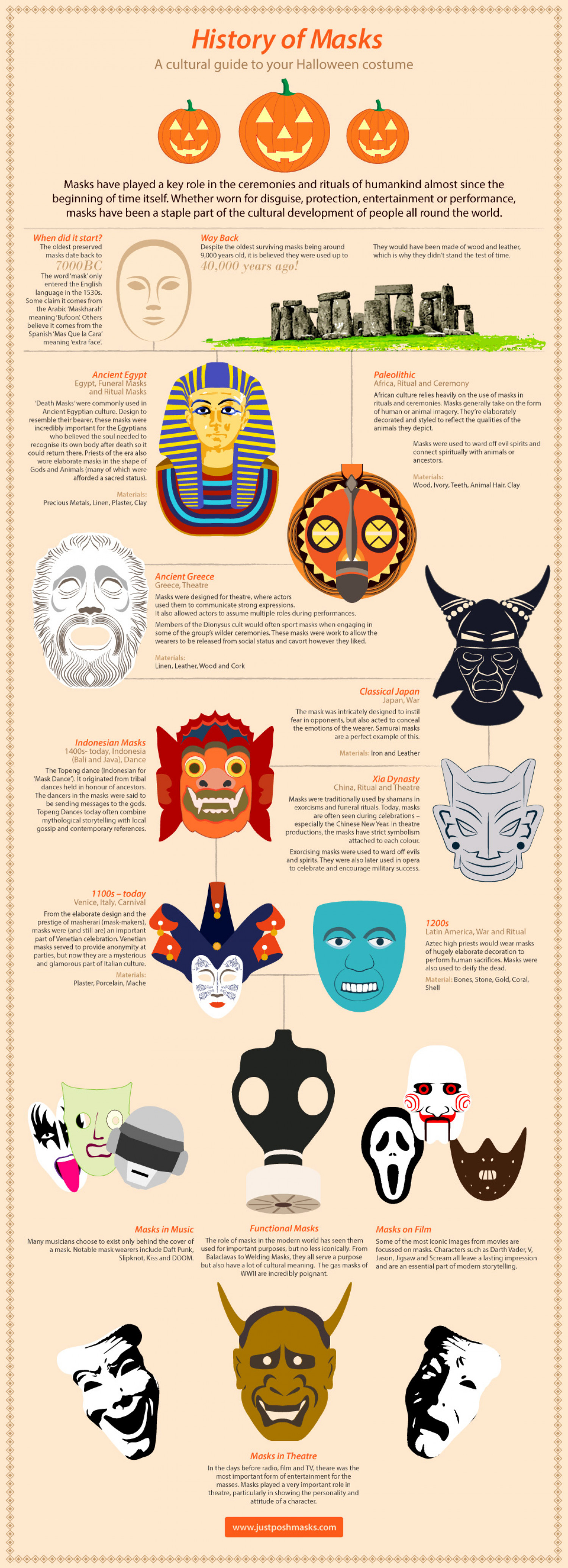
A History of Masks for Halloween
History of Masks A cultural guide to your Halloween costume Masks have played a key role in the ceremonies and rituals of humankind almost since the beginning of time itself. Whether worn for disguise, protection, entertainment or performance, masks have been a staple part of the cultural development of people all round the world. When did it start? The oldest preserved masks date back to Way Back Despite the oldest surviving masks being around 9,000 years old, it is believed they were used up to 40,000 years ago! They would have been made of wood and leather, which is why they didn't stand the test of time. 7000BC The word 'mask'only entered the English language in the 1530s. Some claim it comes from the Arabic'Maskharah' meaning 'Bufoon: Others believe it comes from the Spanish 'Mas Que la Cara' meaning 'extra face Ancient Egypt Egypt, Funeral Masks and Ritual Masks Paleolithic Africa, Ritual and Ceremony 'Death Masks' were commonly used in Ancient Egyptian culture. Design to resemble their bearer, these masks were incredibly important for the Egyptians who believed the soul needed to African culture relies heavily on the use of masks in rituals and ceremonies. Masks generally take on the form of human or animal imagery. They're elaborately decorated and styled to reflect the qualities of the animals they depict. Masks were used to ward off evil spirits and recognise its own body after death so it could return there. Priests of the era also connect spiritually with animals or ancestors. wore elaborate masks in the shape of Gods and Animals (many of which were afforded a sacred status). Materials: Wood, Ivory, Teeth, Animal Hair, Clay Materials: Precious Metals, Linen, Plaster, Clay Ancient Greece Greece, Theatre Masks were designed for theatre, where actors used them to communicate strong expressions. It also allowed actors to assume multiple roles during performances. Members of the Dionysus cult would often sport masks when engaging in some of the group's wilder ceremonies. These masks were work to allow the wearers to be released from social status and cavort however they liked. Materials: Linen, Leather, Wood and Cork Classical Japan Japan, War The mask was intricately designed to instil fear in opponents, but also acted to conceal the emotions of the wearer. Samurai masks are a perfect example of this. Indonesian Masks 1400s- today, Indonesia (Bali and Java), Dance Materials: Iron and Leather The Topeng dance (Indonesian for 'Mask Dance'). It originated from tribal dances held in honour of ancestors. Xia Dynasty China, Ritual and Theatre The dancers in the masks were said to be sending messages to the gods. Topeng Dances today often combine mythological storytelling with local gossip and contemporary references. Masks were traditionally used by shamans in exorcisms and funeral rituals. Today, masks are often seen during celebrations - especially the Chinese New Year. In theatre productions, the masks have strict symbolism attached to each colour. Exorcising masks were used to ward off evils and spirits. They were also later used in opera to celebrate and encourage military success. 1100s - today Venice, Italy, Carnival From the elaborate design and the prestige of masherari (mask-makers), masks were (and still are) an important part of Venetian celebration. Venetian masks served to provide anonymity at 1200s Latin America, War and Ritual Aztec high priests would wear masks of hugely elaborate decoration to perform human sacrifices. Masks were also used to deify the dead. parties, but now they are a mysterious and glamorous part of Italian culture. Materials: Material: Bones, Stone, Gold, Coral, Shell Plaster, Porcelain, Mache Masks in Music Functional Masks Masks on Film The role of masks in the modern world has seen them Some of the most iconic images from movies are From focussed on masks. Characters such as Darth Vader, V, Jason, Jigsaw and Scream all leave a lasting impression but also have a lot of cultural meaning. The gas masks of and are an essential part of modern storytelling. Many musicians choose to exist only behind the cover of ortant purposes, b Balaclavas to Welding Masks, they all serve a purpose no less a mask. Notable mask wearers include Daft Punk, used for Slipknot, Kiss and DOOM. wWil are incredibly poignant. Masks in Theatre In the days before radio, film and TV, theare was the most important form of entertainment for the masses. Masks played a very important role in theatre, particularly in showing the personality and attitude of a character. www.justposhmasks.com
A History of Masks for Halloween
Source
Unknown. Add a sourceCategory
LifestyleGet a Quote









